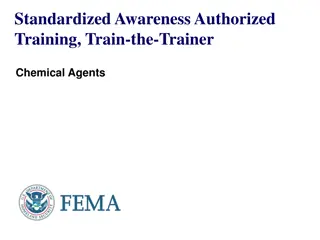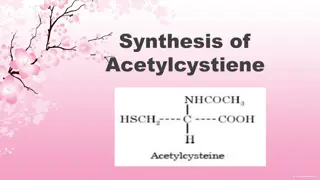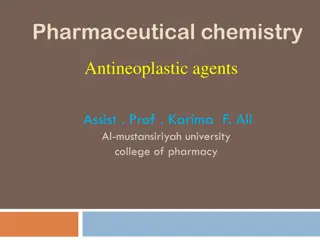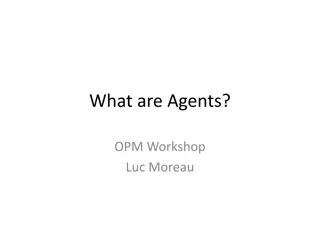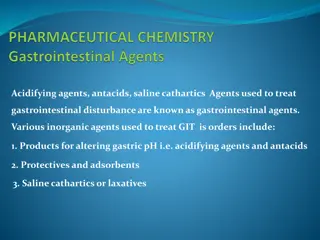
Understanding Chelating Agents in Pharmacology
Explore the role of chelating agents in treating heavy metal poisonings by forming stable complexes with toxic metals. Learn about the properties of ideal chelators and their mechanism of action in eliminating metal ions from the body. Discover how metal toxicity effects depend on various factors and the importance of timely chelator administration in enhancing efficacy.
Download Presentation

Please find below an Image/Link to download the presentation.
The content on the website is provided AS IS for your information and personal use only. It may not be sold, licensed, or shared on other websites without obtaining consent from the author. If you encounter any issues during the download, it is possible that the publisher has removed the file from their server.
You are allowed to download the files provided on this website for personal or commercial use, subject to the condition that they are used lawfully. All files are the property of their respective owners.
The content on the website is provided AS IS for your information and personal use only. It may not be sold, licensed, or shared on other websites without obtaining consent from the author.
E N D
Presentation Transcript
Chelating Agents Dr. Ashok Kumar Jain Pharmacology Department
Chelating Agents Greek chele = crab 1 used in heavy metal poisonings, holds metal like a crab s claw Heavy metals exert toxic effects by combining with (ligands) of enzymes or other critical biomolecules and inactivating functional groups Contain 2 reactive groups (ligands) which can bind metal from at least 2 sides so that a ring is formed. Chelation is Chemical antagonism drug counters the effect of another by simple chemical reaction / neutralization(not binding to the receptor)
Mechanism of action Chelating agent(drug)+Metal ion Non toxic water soluble complex Eliminated by kidney
Metal toxicity toxic effects depend on: Nutritional status Age Gender Route of exposure Amount Tissue distribution Accumulation Excretion
Properties Of Ideal Chelator Greater Affinity, Low Toxicity Ability to compete with natural chelators (include ferritin, transferrin, & lactoferrin for iron, ceruloplasmin for copper, and metallothionein(MT) for other metals) aka Preventative antioxidants rather than protective antioxidants Resistance to bio transformation Ability to reach metal storage sites Capacity to form stable and non toxic complexes Ability to penetrate cell membranes
Properties Of Ideal Chelator High water solubility Rapid excretion of complex Same distribution as the metal Retain chelating ability at pH of body fluids Low affinity for essential metals like Ca and Zn as they often act through competition with these metals Contain 2 reactive groups (ligands) which hold metal from at least two sides so that a ring is formed.(5-7 membered ring is most stable)
Efficacy declines rapidly as the interval increases between metal entry and the administration of the chelator
Ferritin Ferritin mainly present as L-form in body central core where Fe stored as ferric oxohydroxide One ferritin molecule can store up to 4500 atoms of iron All storage proteins have much higher affinity for Fe3+ iron than Fe2+ therefore have to oxidize any Fe2+ for binding (ferroxidase activity) Principally Fe and Cu toxicities related to their abilities to participate in e- transfer reactions. When existing free (most particularly Fe & Cu) can catalyze damaging free radical reactions Extremely reactive hydroxyl radical may generate from O2 in the presence of H2O2 and Fe This reaction mechanism is a type of Fenton chemistry known as the iron-catalyzed Haber- Weiss reaction
Chelating agents useful as drugs: Dimercaprol (BAL) Dimercaptosuccinic acid (Succimer) Penicillamine Desferrioxamine Disodium edetate Deferiprone Calcium disodium edetate Trientine
Chelating agents Drug Antidote (de-Fe-roxamine) Iron Deferoxamine, Deferiprone , Deferasirox Lead/Gold Dimercaprol, Penicillamine,Succimer, (also EDTA for Lead) Copper, Arsenic Penicillamine Arsenic, Mercury, Dimercaprol, Succimer
(Dimercaprol/ BAL) picture from Themis atlas pharmacology 3e,P302
BAL BAL and related and related compound compound
Dimercaprol (British antilewisite; BAL) BAL has 3-carbon backbone c two sulfhydryl ( SH) groups and a hydroxyl group. Oily viscous liquid c pungent mercaptan(rotten egg) smell 1st chelating agent used clinically developed during WW-II by Britishers as antidote to arsenical war gas lewisite. forms complexes between two sulfhydryl groups and arsenic detoxifies lewisite by forming a five membered stable complex with Aresenic Lewisite BAL 5 membered ring complex
Precaution Dimercaprol -metal complex dissociates faster in acidic urine and released metal can damage the kidney Therefore urine is alkalinized during Dimercaprol therapy. C/I in iron and cadmium poisoning as dimercaprol-Fe and dimercaprol-Cd complex is itself toxic
Uses of Dimercaprol (British antilewisite; BAL) Given as deep IM in peanut oil 1. Poisoning by As, Hg, Au, Bi, Ni, Sb: 5 mg/kg stat, followed by 2 3 mg/kg every 4 8 hours for 2 days, then once or twice a day for 10 days. 2. As adjuvant to Cal. disod. edetate in lead poisoning. 3. As adjuvant to penicillamine in Cu poisoning and in Wilson s disease 300 mg/day.
Adverse effects Adverse effects Frequent, dose related ADR: Rise in BP, tachycardia, vomiting, tingling and burning sensations, inflammation of mucous membranes, sweating, cramps, headache and anxiety. Antihistaminics given 30 min before dimercaprol injection reduce the intensity of ADR dimercaprol injection
Dimercaptopropanesulfonic acid (DMPS) 2,3 dimercaptopropane 1 sulfonate whose sodium salt is suitable for oral administration A related compound to BAL both in terms of structure & activity by introduced by Soviet Union
(Succimer) /DMSA 2,3-dimercaptosuccinic acid( DMSA) Similar to dimercaprol in chelating properties, water soluble, less toxic and orally effective. Its efficacy has been demonstrated in As, Hg (mercury) and Pb poisoning. Marketed in USA, but not in India for the treatment of lead intoxication. Side effects are nausea, anorexia and loose motions.
EDTA EDTA ,
EDTA EDTA Potent chelator of calcium causes tetany on i.v. injection. When slow infusion given, tetany not occur, because Ca withdrawn from bones. Can be used for emergency control of hypercalcemia: 50 mg/kg i.v. infusion over 2 4 hours, but bisphosphonates are preferred.
Calcium disodium ethylene diamine tetraacetic acid (CaNa2EDTA) )
CALCIUM DISODIUM EDETATE (CaNa2EDTA) Calcium chelate of Na2 EDTA Hexadentate ("six-toothed") ligand and chelating agent Poorly absorbed in the git (<5%) thus only administered by parenteral route Painful at injection site so iv injection could be given by diluting in 5% D or NS In blood, CaNa2EDTA is found only in the plasma. CaNa2EDTA excreted in urine by glomerular filtration, so adequate renal function is necessary Altering either the pH or the rate of urine flow has no effect on the rate of excretion.
CALCIUM DISODIUM EDETATE (CaNa2EDTA Most important indication lead poisoning due to the capacity of lead to displace calcium from the chelate Also useful in Cu, Mn,Cd, Fe, Zn,
Adverse effects Principal toxic effect on the kidney by degeneration of proximal tubular cells. Excessive thirst An acute febrile reaction with chills, bodyache, malaise, fatigue lacrimation; Glycosuria Anemia Dermatitis with lesions strikingly similar to those of vitamin b6 deficiency; Transitory lowering of systolic and diastolic blood pressures; Prolonged PT; and T-waveinversion on the electrocardiogram
Penicillamine It is dimethyl cysteine, Obtained as a degradation product of penicillin. thiol moiety in penicillamine can chelateCu, Hg, Pb and Zn. D-isomer is used therapeutically, because the l-isomer and the recemate produce optic neuritis and are more toxic. Adequately absorbed after oral administration. Little metabolized in the body and excreted in urine and faeces
Uses Pencillamine Wilson sdisease(Hepatolenticulardegeneration) genetic deficiency of ceruloplasmin, a protein which normally binds and disposes off Cu from the body. In its absence, plasma concentration of free Cu is high which gets deposited in liver, substantia nigra, basal ganglia of brain, and causes degeneration. Copper poisoning drug of choice mercury poisoning Chronic lead poisoning: as adjuvant to CaNa2EDTA, but succimer is preferred alternative drug to dimercaprol/Succimer
Cystinuria and cystine stones: promotes excretion of cysteine and prevents its precipitation in the urinary tract, because penicillamine cysteine complex is more soluble than dicysteine (cystine). Scleroderma: Penicillamine benefits by increasing soluble collagen. As DMARD in Rheumatoid arthritis
Adverse effects: Nausea, vomiting, abdominal discomfort and rashes (often with fever) Loss of taste Oral ulceration Glomerulonephritis/Nephrotic syndrome thrombocytopenia, neutropenia and rarely, aplastic anaemia. lupus-like autoimmune reaction antipyridoxine effect Myasthenia gravis
Trientine Trientine (triethylenetetramine dihydrochloride) orally alternative for patients with Wilson disease who are intolerant of penicillamine
(Deferoxamine) picture from Themis atlas pharmacology 3e,P302
Desferrioxamine Desferrioxamine/ /Deferoxamine Obtained from an actinomycete- Streptomyces pilosus Deferoxamine/DFO /DFO Straight chain DFO molecule winds around fe3+ and forms a stable nontoxic complex and excreted in urine as ferrioxamine Removes loosely bound Fe as well as that from haemosiderin and ferritin, but not from haemoglobin or cytochrome. Absorption poor after PO ---Parenterally administered. (im/iv/sc) Very high affinity for iron: 1g is capable of chelating 85 mg of elemental iron.
Desferrioxamine indications 1. Acute iron poisoning: mostly seen in children 2. Transfusion siderosis: occurs in thalassemic who receive repeated BT 0.5 1 g/day i.m. helps to excrete the chronic iron overload; i.v. concurrently with blood transfusion 2 g per unit of blood 3. With hemodialysis for aluminum toxicity in renal failure
Desferrioxamine adverse effects: High frequency hearing loss / Tinnitus Vision: loss of visual acuity, field defects, night vision or color vision Impaired growth and skeletal development Lung toxicity (pulmonary syndrome) Increased risk of infection (Yersinia) Can cause histamine release fall in BP, flushing, itching, urticaria, rashes. "vin ros," or deep red wine colored, urine is produced. .
Deferiprone Deferiprone Orally active iron chelator which has simplified the treatment of transfusion siderosis in thalassemia patients. Excessive haemolysis occurs in these patients, and they have to be given repeated blood transfusions. An iron chelator has to be used to clear the resulting iron overload.
Deferiprone Deferiprone Oral deferiprone is a somewhat less effective alternative to injected desferrioxamine. Deferiprone has also been indicated for acute iron poisoning(less effective than desferrioxamine) and for iron load in liver cirrhosis.
Deferiprone Deferiprone Side effects Anorexia, vomiting, altered taste, joint pain, reversible neutropenia, rarely agranulocytosis.Long-term safety is not yet known.
Summary Copper Penicillamine, trientine(Copper penny) Iron Deferoxamine, deferasirox, deferiprone Lead EDTA, dimercaprol, succimer, penicillamine Mercury Dimercaprol, succimer

